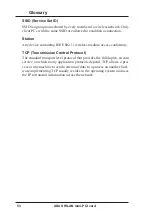
ASUS WLAN mini-PCI card
5
2
Glossary
Chapter 4
ISP (Internet Service Provider)
An organization that provides access to the Internet. Small ISPs provide
service via modem and ISDN while the larger ones also offer private line
hookups (T1, fractional T1, etc.).
LAN (Local Area Network)
A communications network that serves users within a defined geographi-
cal area. The benefits include the sharing of Internet access, files and equip-
ment like printers and storage devices. Special network cabling (10 BaseT)
is often used to connect the PCs together.
NIC (Network Interface Card)
A network adapter inserted into a computer so that the computer can be
connected to a network. It is responsible for converting data from stored in
the computer to the form transmitted or received.
Packet
A basic message unit for communication across a network. A packet usu-
ally includes routing information, data, and sometimes error detection in-
formation.
PCMCIA
(Personal Computer Memory Card International Association)
The Personal Computer Memory Card International Association (PCMCIA),
develops standards for PC cards, formerly known as PCMCIA cards. These
cards are available in three types, and are have about the same length and
width as credit cards. However, the different width of the cards ranges in
thickness from 3.3 mm (Type I) to 5.0 mm (Type II) to 10.5 mm (Type III).
These cards can be used for various functions, including memory storage,
landline modems and wireless modems.
Radio Frequency (RF) Terms: GHz, MHz, Hz
The international unit for measuring frequency is Hertz (Hz), equivalent to
the older unit of cycles per second. One megahertz (MHz) is one million
Hertz. One gigahertz (GHz) is one billion Hertz. The standard US electri-
cal power frequency is 60 Hz, the AM broadcast radio frequency band is
0.55-1.6 MHz, the FM broadcast radio frequency band is 88-108 MHz,
and wireless 802.11 LANs operate at 2.4 GHz.




































